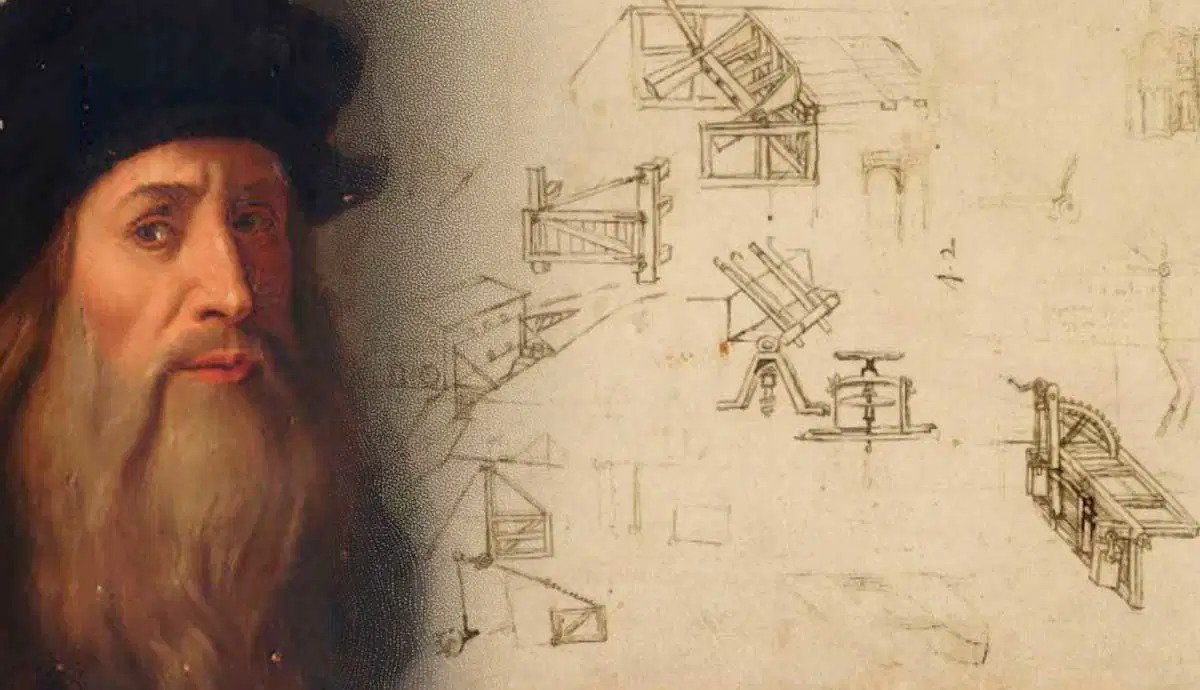Table of Contents
ToggleTop 8 Unknown and Interesting Facts About Leonardo da Vinci’s Unfinished Inventions
In addition to being one of the most well-known artists in history, Leonardo da Vinci is also regarded as a visionary inventor. Due to his propensity to switch between projects or the constraints of the technology available at the time, a sizable percentage of his innovations remained unfinished, even though many of them were ahead of their time. Let’s examine some of these intriguing, unfinished creations, examining their nature, potential operational mechanisms, and current significance.

1. The Flying Machine: Leonardo’s Dreams of Flight
Centuries before the Wright Brothers succeeded in achieving human flight, Leonardo da Vinci was fascinated by the concept. His drawings depict a variety of ideas influenced by the anatomy of birds, ranging from glider-like structures to ornithopters, which are devices made to resemble flapping wings.
The “ornithopter,” one of his most well-known flying machine designs, with a wingspan of about 33 feet. It used human power to flap the wings by having a pilot lie flat on a board and pump a number of pulleys and levers.
Leonardo never constructed anything, but his meticulousness and calculations demonstrate a profound comprehension of anatomy and aerodynamics. The designs, which show intricate wing shapes intended to lift and propel a human body, demonstrate his interest of watching birds and analyzing their movement.
According to Leonardo, birds possess “a natural knowledge of physics,” which he regarded as divine and which led him to believe that, with the correct information, humans could also fly. His belief that nature contained the keys to technology was hinted at by the fact that a substantial portion of his flying vehicles were based on research into birds, bats, and other creatures.
2. The Armored Tank: A War Machine from the Renaissance
Leonardo da Vinci envisioned a machine that would revolutionize combat centuries before the contemporary tank was created. In order to fire in all directions, his armored tank design had a round, turtle-shaped shell covered in iron plates, surrounded by a variety of cannons. Men within the shell were supposed to operate a set of cranks and wheels that drove the tank.
But the design had a serious flaw: the cranks were oriented in opposite directions, which prevented the vehicle from moving forward. Given that da Vinci was known to have strong anti-war beliefs despite working for warlike clientele, some historians think this defect was deliberate. It’s possible that he purposefully placed a weakness in his design to keep it from being used in battle.
It is thought that Leonardo’s drawings of the tank include secret messages. Mirror writing, in which he wrote from right to left to keep his thoughts secret and keep them out of the wrong hands, was one of his well-known habits. His military designs, which he might not have intended to be employed for violent purposes, were particularly pertinent to this.
3. The Giant Crossbow: Leonardo’s Vision of Psychological Warfare
Unlike his tank design, Leonardo’s giant crossbow was intended to be built and used. Known as the “Giant Crossbow” or “Great Crossbow,” it was designed to instill fear in the enemy rather than inflict physical damage. Measuring an astonishing 27 yards across, the crossbow was to be mounted on large wheels and capable of launching giant projectiles, such as flaming barrels or large stones.
This invention emphasized the psychological aspects of warfare that da Vinci understood well. The mere sight of such a massive weapon would have been intimidating, which may have been the primary intention. Although the giant crossbow was never built, it showcased Leonardo’s understanding of both mechanics and psychology.
Unlike his other military designs, which were often complex, the giant crossbow was relatively simple, likely to encourage its construction. Leonardo’s meticulous drawings reveal a device that could be rapidly assembled and dismantled, reflecting his knowledge of the practicalities of war logistics.
4. The Self-Propelled Cart: A Renaissance Robot
Leonardo da Vinci is credited with designing the world’s first self-propelled cart, a precursor to the modern automobile. This self-propelled vehicle was powered by coiled springs and designed to move without being pushed or pulled. The cart was also equipped with a rudimentary steering system, making it capable of traveling on a predetermined path.
Though da Vinci’s self-propelled cart was never built during his lifetime, modern engineers have reconstructed it based on his sketches, confirming that the design could indeed work. This invention is an example of Leonardo’s incredible foresight and his understanding of mechanics. It’s remarkable to consider that in an age where people relied on animals for transportation, Leonardo was imagining a world with automated vehicles.
The cart is often referred to as “Leonardo’s robot” because it shares similarities with modern robotics. It could be programmed to move a certain distance and change direction, a concept that closely aligns with the principles of automation and robotics seen today.
5. The Diving Suit: A Pioneer in Underwater Exploration
Leonardo da Vinci also conceptualized a suit that would allow humans to explore underwater, which could have revolutionized naval warfare by allowing soldiers to sabotage enemy ships. His design for the diving suit included a leather outfit with air tubes connected to a floating device at the surface, allowing the wearer to breathe underwater.
The suit was equipped with a bag to collect urine, a necessary addition for extended underwater operations. Although Leonardo’s diving suit was never produced, his sketches suggest an understanding of underwater pressure and the basics of a closed-breathing system, which were revolutionary for his time.
Leonardo’s diving suit wasn’t just functional—it was tactical. He anticipated its use in Venetian naval warfare, imagining divers who could discreetly sabotage enemy ships by cutting holes in their hulls. This shows that Leonardo’s ideas extended beyond pure science and into practical applications for military strategy.
6. The Parachute: Da Vinci’s Exploration of Air Resistance
In the 15th century, the concept of a parachute was virtually unheard of, but Leonardo da Vinci sketched a pyramid-shaped parachute design that would allow a person to descend safely from great heights. His design consisted of a wooden frame covered in tightly woven cloth, resembling a modern parachute but with a solid structure.
Though his parachute was never built in his lifetime, modern researchers have tested his design and found that it works, although it is much heavier and less practical than modern parachutes. Leonardo’s interest in the parachute showcases his understanding of air resistance and gravity—concepts that wouldn’t be scientifically established for centuries.
Leonardo’s notes on the parachute describe a device that would allow a person to “throw himself down from any great height without suffering any injury,” showing his fascination with creating technology to transcend human limitations.
7. The Ideal City: Leonardo’s Vision of Urban Planning
During the Renaissance, cities were often overcrowded, unsanitary, and prone to disease outbreaks. Leonardo da Vinci envisioned a city with better infrastructure, hygiene, and organization. His “Ideal City” design included wide streets, efficient sewage systems, and canals for transportation. It reflected Leonardo’s understanding of the social and health issues caused by poor urban planning.
Unfortunately, his vision of an ideal city was never realized, as the resources and technology of his time weren’t adequate for such a massive project. However, Leonardo’s urban designs influenced future city planners, laying the groundwork for modern concepts of public health and hygiene in city planning.
Leonardo’s notes on city planning reveal his humanitarian side. He envisioned a city that would provide its citizens with a higher quality of life, including clean air, spacious public areas, and efficient waste disposal, emphasizing his progressive thinking about human welfare and community health.
8. The Mechanical Knight: The Renaissance Robot
Leonardo da Vinci’s sketches reveal plans for a mechanical knight, an early attempt at robotics. This “robot” could stand, sit, raise its arms, and move its jaw—remarkable feats for the 15th century. Powered by a complex system of pulleys, gears, and cables, the mechanical knight is often seen as an ancestor of modern robots.
Though it’s uncertain whether Leonardo ever built the mechanical knight, his sketches show a deep understanding of anatomy and mechanical engineering. The mechanical knight was intended for entertainment or to be used in pageants, demonstrating Leonardo’s creativity and his interest in automated movement.
In 2002, robotics experts successfully reconstructed Leonardo’s mechanical knight based on his sketches, and it worked as intended. This experiment demonstrated Leonardo’s incredible foresight and his potential to revolutionize technology centuries before the Industrial Revolution.


